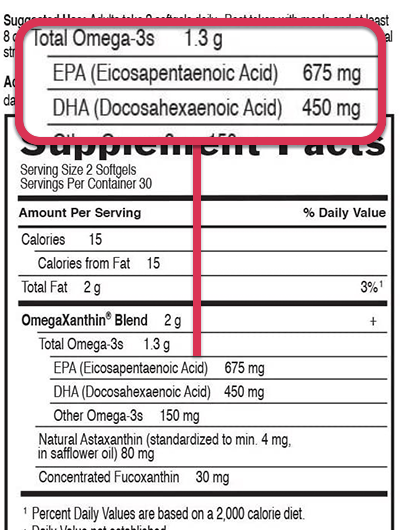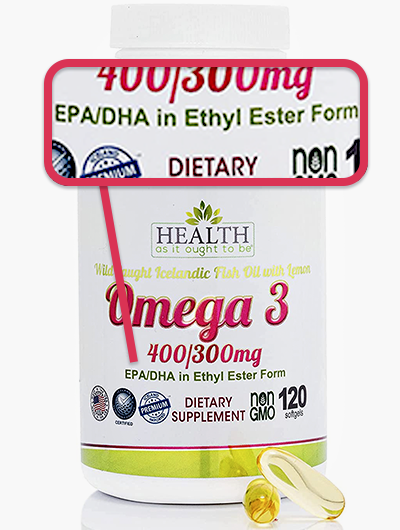Omega-3’s are provided in varying fatty acid forms: ethyl esters, triglycerides, and monoglycerides. Which should you choose? You may be surprised that ethyl esters aren’t the best form if you want best absorption of your Omega-3’s. The triglyceride form is better than ethyl ester, and the monoglyceride form is best.


Fats That Help You vs Fats That Harm You
At first thought, fat seems like a simple thing. When we read a nutrition label, it looks like all that matters is how many grams of fat there are and how much is “saturated” or “unsaturated.” We get no information that different fats in each of those categories affect us differently, some for good, and some for bad.
What makes dietary fats differ from each other is their fatty acids. Each fat has three of these. Because of this, another name for a fat is a triglyceride. Different fatty acids result in different effects for your body.
Different foods have different balances of fatty acids, and nutritional supplements can be rich or poor in beneficial fatty acids.


Omega-3 Fatty Acids: Vital But Our Bodies Can’t Produce Them!
Omega-3 fatty acids are a group all sharing one feature: a double bond in the third position. But not all Omega-3’s share the same benefits.
DHA and EPA are the crucial Omega-3 fatty acids for you to look for, and the only two that are needed. Multiple studies show cardiovascular health benefits from DHA and EPA supplementation as well as anti-inflammatory effects and even benefits to weight management and metabolic syndrome.
The human body cannot produce Omega-3 fatty acids. They can only come from food, or from nutritional supplements. (The body does have a very limited capacity to convert one Omega-3 to another.)
Recommendations for DHA+EPA intake vary typically from 1 g/day to 4 g/day according to differing authorities.
However, as absorption varies according to how Omega-3’s are supplied, gram values alone don’t tell the whole story.
Typical DHA+EPA intake in the United States has been found to be only about 0.11 g/day. That value is far short of a recommended 1 g/day, let alone 4 grams.

Are Omega-3 Ethyl Esters the Best?
If you wonder what Omega-3 ethyl esters are, that’s a really good question. They don’t substantively exist in nature. They are not part of the food supply. So why do people supplement with them?
The answer is manufacturing convenience.
Fish oils are the most efficient source of DHA and EPA. However they are not highly concentrated. Without any concentration process, you’d have to take a lot of softgels to get 1 g/day of Omega-3’s.
Another issue is that fish oils can be contaminated with mercury. A purification process to get rid of mercury is certainly a good thing, so many manufacturers have chosen to do this.
Both of these are easily accomplished by breaking fish oil (as the triglycerides mentioned before) to free fatty acids, then make ethyl esters of them, and finally distill them under vacuum. The resulting product can be concentrated in DHA and EPA and be essentially free of mercury.
The cheapest thing to do is to stop right there and put that into softgels. It’s not the best way and it’s certainly unnatural, but it’s not bad and it saves the manufacturer money.

Triglyceride Omega-3’s Are Better Than Ethyl Esters
Can a fish oil, which starts out as natural triglycerides, be concentrated for higher DHA and EPA, purified of mercury, and still be provided in softgels as triglycerides? Didn’t we have to turn fish oil into ethyl esters to purify it?
Yes, and yes!
A manufacturer willing to take an extra step of care can use an enzyme process to turn purified Omega-3 ethyl esters back to the natural and better-absorbed triglyceride form.
How does this affect you? If having a choice between an ethyl esters product and a triglyceride product and all else is about equal, the triglyceride product will be your better choice because absorption is better.

King of the Softgel Fish Oils: Monoglyceride Omega-3’s
As natural and good as the triglyceride form is, can anyone provide a still better product?
Or are the triglyceride forms natural?
Well, by modern definition the above Omega-3 triglyceride products can be called “natural,” but they do differ from anything found substantially in nature. However, they have two or three DHA or EPA fatty acids per molecule, while natural fats high in Omega-3 typically have only one Omega-3 fatty acid per molecule.
Might we do better to do as Nature does? In this case as with many others, yes.
A key point in why this is that we don’t absorb fats as the entire molecules. Our digestive system has to break them down before absorption. Fats are digested down at least to having only one fatty acid per molecule in other words, to monoglycerides. Could we obtain large advantages by providing Omega-3’s this way? After, of course, following equally effective purification steps?
From research, the answer is a resounding yes.
Monoglyceride Omega-3’s can be absorbed twice as much as triglyceride Omega-3’s, and three times more than ethyl ester Omega-3’s. Reasons for this may include that monoglycerides more readily emulsify in the digestive system and that they are directly absorbable.
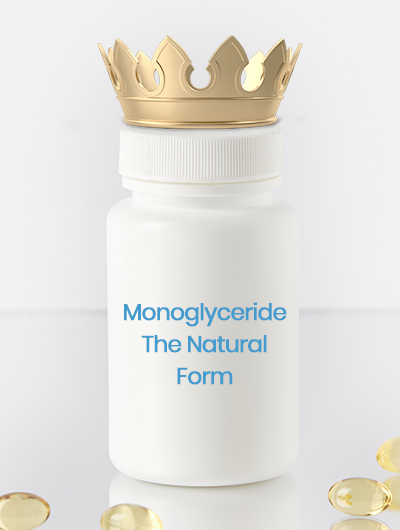
Summary
If you wish to supplement your diet with Omega-3’s, look not only for gram or milligram dosage but also the form of the product. Ethyl ester, triglyceride, and monoglyceride Omega-3 supplements can all work for you, but of these, ethyl esters are the least well absorbed, triglycerides are better absorbed, and monoglycerides are best absorbed of all.
References
[1] Cuenoud B, Rochat I, Gosoniu ML, et al. Monoacylglycerol Form of Omega-3s Improves Its Bioavailability in Humans Compared to Other Forms. Nutrients. 2020;12(4):1014. Published 2020 Apr 7. doi:10.3390/nu12041014
[2] Chevalier L, Vachon A, Plourde M. Pharmacokinetics of Supplemental Omega-3 Fatty Acids Esterified in Monoglycerides, Ethyl Esters, or Triglycerides in Adults in a Randomized Crossover Trial. J Nutr. 2021;151(5):1111-1118. doi:10.1093/jn/nxaa458
[3] Chevalier L, Plourde M. Comparison of pharmacokinetics of omega-3 fatty acid supplements in monoacylglycerol or ethyl ester in humans: a randomized controlled trial. Eur J Clin Nutr. 2021;75(4):680-688. doi:10.1038/s41430-020-00767-4
[4] Schuchardt JP, Hahn A. Bioavailability of long-chain omega-3 fatty acids. Prostaglandins Leukot Essent Fatty Acids. 2013;89(1):1-8. doi:10.1016/j.plefa.2013.03.010
[5] Abdelhamid AS, Brown TJ, Brainard JS, et al. Omega-3 fatty acids for the primary and secondary prevention of cardiovascular disease. Cochrane Database Syst Rev. 2018;7(7):CD003177. Published 2018 Jul 18. doi:10.1002/14651858.CD003177.pub3
[6] Huang CW, Chien YS, Chen YJ, Ajuwon KM, Mersmann HM, Ding ST. Role of n-3 Polyunsaturated Fatty Acids in Ameliorating the Obesity-Induced Metabolic Syndrome in Animal Models and Humans. Int J Mol Sci. 2016;17(10):1689. Published 2016 Oct 9. doi:10.3390/ijms17101689
[7] Arnoldussen IA, Kiliaan AJ. Impact of DHA on metabolic diseases from womb to tomb. Mar Drugs. 2014;12(12):6190-6212. Published 2014 Dec 18. doi:10.3390/md12126190
[8] da Cunha de Sá RDC, Cruz MM, de Farias TM, et al. Fish oil reverses metabolic syndrome, adipocyte dysfunction, and altered adipokines secretion triggered by high-fat diet-induced obesity. Physiol Rep. 2020;8(4):e14380. doi:10.14814/phy2.14380
[9] Tabbaa M, Golubic M, Roizen MF, Bernstein AM. Docosahexaenoic acid, inflammation, and bacterial dysbiosis in relation to periodontal disease, inflammatory bowel disease, and the metabolic syndrome. Nutrients. 2013;5(8):3299-3310. Published 2013 Aug 19. doi:10.3390/nu5083299
[10] Amatruda M, Ippolito G, Vizzuso S, Vizzari G, Banderali G, Verduci E. Epigenetic Effects of n-3 LCPUFAs: A Role in Pediatric Metabolic Syndrome. Int J Mol Sci. 2019;20(9):2118. Published 2019 Apr 29. doi:10.3390/ijms20092118
[11] Welty FK, Alfaddagh A, Elajami TK. Targeting inflammation in metabolic syndrome. Transl Res. 2016;167(1):257-280. doi:10.1016/j.trsl.2015.06.017
[12] Rupp H, Wagner D, Rupp T, Schulte LM, Maisch B. Risk stratification by the "EPA+DHA level" and the "EPA/AA ratio" focus on anti-inflammatory and antiarrhythmogenic effects of long-chain omega-3 fatty acids. Herz. 2004;29(7):673-685. doi:10.1007/s00059-004-2602-4
[13] von Schacky C, Harris WS. Cardiovascular benefits of omega-3 fatty acids. Cardiovasc Res. 2007;73(2):310-315. doi:10.1016/j.cardiores.2006.08.019
[14] Bradbury J. Docosahexaenoic acid (DHA): an ancient nutrient for the modern human brain. Nutrients. 2011;3(5):529-554. doi:10.3390/nu3050529
[15] Hathaway D, Pandav K, Patel M, et al. Omega 3 Fatty Acids and COVID-19: A Comprehensive Review. Infect Chemother. 2020;52(4):478-495. doi:10.3947/ic.2020.52.4.478
-
Vegan Fish Oil Supplements
By Dr. KarenMarch 8, 2022 -
Fish Oil for Weight Loss
By Dr. KarenMarch 8, 2022
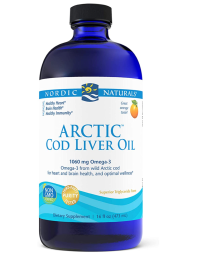

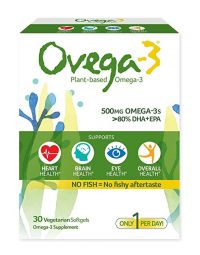
Search the blog
Article Categories
- All Articles (95)
- Rating Charts (1)
- Beauty & Skincare (17)
- FAQ (0)
- Hair Care (9)
- Health & Wellness (12)
- Anti-Aging (4)
- Kid's Health (0)
- Makeup (2)
- Men's Health (2)
- Oral Care (3)
- Sunscreen (7)
- Skin Tools & Treatments (10)
- Supplements (26)
- Videos (0)

